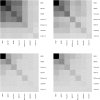Medication-indication knowledge bases: a systematic review and critical appraisal
- PMID: 26335981
- PMCID: PMC5009909
- DOI: 10.1093/jamia/ocv129
Medication-indication knowledge bases: a systematic review and critical appraisal
Abstract
Objective: Medication-indication information is a key part of the information needed for providing decision support for and promoting appropriate use of medications. However, this information is not readily available to end users, and a lot of the resources only contain this information in unstructured form (free text). A number of public knowledge bases (KBs) containing structured medication-indication information have been developed over the years, but a direct comparison of these resources has not yet been conducted.
Material and methods: We conducted a systematic review of the literature to identify all medication-indication KBs and critically appraised these resources in terms of their scope as well as their support for complex indication information.
Results: We identified 7 KBs containing medication-indication data. They notably differed from each other in terms of their scope, coverage for on- or off-label indications, source of information, and choice of terminologies for representing the knowledge. The majority of KBs had issues with granularity of the indications as well as with representing duration of therapy, primary choice of treatment, and comedications or comorbidities.
Discussion and conclusion: This is the first study directly comparing public KBs of medication indications. We identified several gaps in the existing resources, which can motivate future research.
Keywords: appropriateness; drug therapy; electronic health records; indication; off-label use.
© The Author 2015. Published by Oxford University Press on behalf of the American Medical Informatics Association. All rights reserved. For Permissions, please email: journals.permissions@oup.com.
Figures



Similar articles
-
Risk of thromboembolism in patients with COVID-19 who are using hormonal contraception.Cochrane Database Syst Rev. 2023 Jan 9;1(1):CD014908. doi: 10.1002/14651858.CD014908.pub2. Cochrane Database Syst Rev. 2023. Update in: Cochrane Database Syst Rev. 2023 May 15;5:CD014908. doi: 10.1002/14651858.CD014908.pub3. PMID: 36622724 Free PMC article. Updated.
-
What is the value of routinely testing full blood count, electrolytes and urea, and pulmonary function tests before elective surgery in patients with no apparent clinical indication and in subgroups of patients with common comorbidities: a systematic review of the clinical and cost-effective literature.Health Technol Assess. 2012 Dec;16(50):i-xvi, 1-159. doi: 10.3310/hta16500. Health Technol Assess. 2012. PMID: 23302507 Free PMC article.
-
Short-Term Memory Impairment.2024 Jun 8. In: StatPearls [Internet]. Treasure Island (FL): StatPearls Publishing; 2025 Jan–. 2024 Jun 8. In: StatPearls [Internet]. Treasure Island (FL): StatPearls Publishing; 2025 Jan–. PMID: 31424720 Free Books & Documents.
-
[Volume and health outcomes: evidence from systematic reviews and from evaluation of Italian hospital data].Epidemiol Prev. 2013 Mar-Jun;37(2-3 Suppl 2):1-100. Epidemiol Prev. 2013. PMID: 23851286 Italian.
-
Home treatment for mental health problems: a systematic review.Health Technol Assess. 2001;5(15):1-139. doi: 10.3310/hta5150. Health Technol Assess. 2001. PMID: 11532236
Cited by
-
Pharmacy Informatics: Where Medication Use and Technology Meet.Can J Hosp Pharm. 2019 Jul-Aug;72(4):320-326. Epub 2018 Aug 31. Can J Hosp Pharm. 2019. PMID: 31452544 Free PMC article. No abstract available.
-
An updated, computable MEDication-Indication resource for biomedical research.Sci Rep. 2021 Sep 23;11(1):18953. doi: 10.1038/s41598-021-98579-4. Sci Rep. 2021. PMID: 34556781 Free PMC article.
-
Diabetes Mellitus and Its Therapy in Brunei Darussalam - A Critical Revisit.Patient Prefer Adherence. 2023 Apr 22;17:1131-1136. doi: 10.2147/PPA.S366152. eCollection 2023. Patient Prefer Adherence. 2023. PMID: 37124833 Free PMC article. Review.
-
InContext: curation of medical context for drug indications.J Biomed Semantics. 2021 Feb 12;12(1):2. doi: 10.1186/s13326-021-00234-4. J Biomed Semantics. 2021. PMID: 33579375 Free PMC article.
-
Developing a Data-driven Medication Indication Knowledge Base using a Large Scale Medical Claims Database.AMIA Jt Summits Transl Sci Proc. 2019 May 6;2019:741-750. eCollection 2019. AMIA Jt Summits Transl Sci Proc. 2019. PMID: 31259031 Free PMC article.
References
-
- Weingart SN, Simchowitz B, Padolsky H, et al. An empirical model to estimate the potential impact of medication safety alerts on patient safety, health care utilization, and cost in ambulatory care. Arch Intern Med 2009;169(16):1465–1473. - PubMed
-
- Fitzgerald LS, Hanlon JT, Shelton PS, et al. Reliability of a modified medication appropriateness index in ambulatory older persons. Ann Pharmacother 1997;31(5):543–548. - PubMed
-
- Radley DC, Finkelstein SN, Stafford RS. Off-label prescribing among office-based physicians. Arch Intern Med 2006;166(9):1021–1026. - PubMed
Publication types
MeSH terms
Grants and funding
LinkOut - more resources
Full Text Sources
Other Literature Sources

